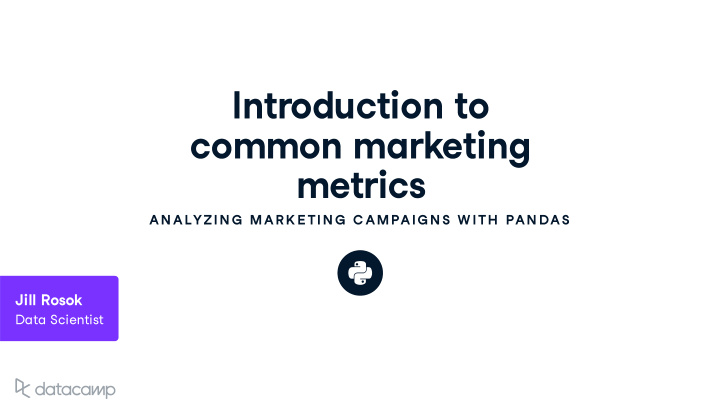



Introd u ction to common marketing metrics AN ALYZIN G MAR K E TIN G C AMPAIG N S W ITH PAN DAS Jill Rosok Data Scientist
Was the campaign s u ccessf u l ? Common metrics : Con v ersion rate Retention rate ANALYZING MARKETING CAMPAIGNS WITH PANDAS
Con v ersion rate Number of people who convert Conversion rate = Total number of people we marketed to ANALYZING MARKETING CAMPAIGNS WITH PANDAS
Calc u lating con v ersion rate u sing pandas subscribers = marketing[marketing['converted'] == True]\ ['user_id'].nunique() total = marketing['user_id'].nunique() conv_rate = subscribers/total print(round(conv_rate*100, 2), '%') 13.89 % ANALYZING MARKETING CAMPAIGNS WITH PANDAS
Retention rate Number of people who remain subscribed Retention rate = Total number of people who converted ANALYZING MARKETING CAMPAIGNS WITH PANDAS
Calc u lating retention rate retained = marketing[marketing['is_retained'] == True]\ ['user_id'].nunique() subscribers = marketing[marketing['converted'] == True]\ ['user_id'].nunique() retention = retained/subscribers print(round(retention*100, 2), '%') 84% ANALYZING MARKETING CAMPAIGNS WITH PANDAS
Let ' s practice ! AN ALYZIN G MAR K E TIN G C AMPAIG N S W ITH PAN DAS
C u stomer segmentation AN ALYZIN G MAR K E TIN G C AMPAIG N S W ITH PAN DAS Jill Rosok Data Scientist
Common w a y s to segment a u diences Age Gender Location Past interaction ( s ) w ith the b u siness Marketing channels u sers interacted w ith ANALYZING MARKETING CAMPAIGNS WITH PANDAS
Segmenting u sing pandas # Subset to include only House Ads house_ads = marketing\ [marketing['subscribing_channel'] == 'House Ads'] retained = house_ads[house_ads['is_retained'] == True]\ ['user_id'].nunique() subscribers = house_ads[house_ads['converted'] == True]\ ['user_id'].nunique() retention_rate = retained/subscribers print(round(retention_rate*100,2), '%') 58.05 % ANALYZING MARKETING CAMPAIGNS WITH PANDAS
There m u st be an easier w a y to segment ! ANALYZING MARKETING CAMPAIGNS WITH PANDAS
Segmenting u sing pandas - gro u pb y() # Group by subscribing_channel and calculate retention retained = marketing[marketing['is_retained'] == True]\ .groupby(['subscribing_channel'])\ ['user_id'].nunique() print(retained) subscribing_channel Email 109 Facebook 152 House Ads 173 Instagram 158 Push 54 Name: user_id, dtype: int64 ANALYZING MARKETING CAMPAIGNS WITH PANDAS
Segmenting u sing pandas - gro u pb y() # Group by subscribing_channel and calculate subscribers subscribers = marketing[marketing['converted'] == True]\ .groupby(['subscribing_channel'])\ ['user_id'].nunique() print(subscribers) subscribing_channel Email 125 Facebook 221 House Ads 298 Instagram 232 Push 77 Name: user_id, dtype: int64 ANALYZING MARKETING CAMPAIGNS WITH PANDAS
Segmenting res u lts # Calculate the retention rate across the DataFrame channel_retention_rate = (retained/subscribers)*100 print(channel_retention_rate) subscribing_channel Email 87.200000 Facebook 68.778281 House Ads 58.053691 Instagram 68.103448 Push 70.129870 Name: user_id, dtype: float64 ANALYZING MARKETING CAMPAIGNS WITH PANDAS
Let ' s practice ! AN ALYZIN G MAR K E TIN G C AMPAIG N S W ITH PAN DAS
Plotting campaign res u lts ( I ) AN ALYZIN G MAR K E TIN G C AMPAIG N S W ITH PAN DAS Jill Rosok Data Scientist
Comparing lang u age con v ersion rates import matplotlib.pyplot as plt # Create a bar chart using channel retention DataFrame language_conversion_rate.plot(kind = 'bar') # Add a title and x and y-axis labels plt.title('Conversion rate by language\n', size = 16) plt.xlabel('Language', size = 14) plt.ylabel('Conversion rate (%)', size = 14) # Display the plot plt.show() ANALYZING MARKETING CAMPAIGNS WITH PANDAS
ANALYZING MARKETING CAMPAIGNS WITH PANDAS
Calc u lating s u bscriber q u alit y # Group by language_displayed and count unique users total = marketing.groupby(['date_subscribed'])['user_id']\ .nunique() # Group by language_displayed and sum conversions retained = marketing[marketing['is_retained'] == True]\ .groupby(['date_subscribed'])\ ['user_id'].nunique() # Calculate subscriber quality across dates daily_retention_rate = retained/total ANALYZING MARKETING CAMPAIGNS WITH PANDAS
Preparing data to be plotted o v er time # Reset index to turn the Series into a DataFrame daily_retention_rate = pd.DataFrame(daily_retention_rate.reset_index()) # Rename columns daily_retention_rate.columns = ['date_subscribed', 'retention_rate'] ANALYZING MARKETING CAMPAIGNS WITH PANDAS
Vis u ali z ing data trended o v er time # Create a line chart using the daily_retention DataFrame daily_retention_rate.plot('date_subscribed', 'retention_rate') # Add a title and x and y-axis labels plt.title('Daily subscriber quality\n', size = 16) plt.ylabel('1-month retention rate (%)', size = 14) plt.xlabel('Date', size = 14) # Set the y-axis to begin at 0 plt.ylim(0) # Display the plot plt.show() ANALYZING MARKETING CAMPAIGNS WITH PANDAS
ANALYZING MARKETING CAMPAIGNS WITH PANDAS
Let ' s practice ! AN ALYZIN G MAR K E TIN G C AMPAIG N S W ITH PAN DAS
Plotting campaign res u lts ( II ) AN ALYZIN G MAR K E TIN G C AMPAIG N S W ITH PAN DAS Jill Rosok Data Scientist
Gro u ping b y m u ltiple col u mns language = marketing.groupby(['date_served', 'language_preferred'])\ ['user_id'].count() print(language.head()) date_served preferred_language 2018-01-01 Arabic 3 English 351 German 5 Spanish 11 2018-01-02 Arabic 4 Name: user_id, dtype: int64 ANALYZING MARKETING CAMPAIGNS WITH PANDAS
Unstacking after gro u pb y language = pd.DataFrame(language.unstack(level=1)) print(language.head()) preferred_language Arabic English German Spanis date_served 2018-01-01 3.0 351.0 5.0 11.0 2018-01-02 4.0 369.0 6.0 10.0 2018-01-03 3.0 349.0 3.0 8.0 2018-01-04 2.0 313.0 2.0 14.0 2018-01-05 NaN 310.0 1.0 14.0 ANALYZING MARKETING CAMPAIGNS WITH PANDAS
Plotting preferred lang u age o v er time language.plot() plt.title('Daily language preferences') plt.xlabel('Date') plt.ylabel('Users') plt.legend(loc = 'upper right', labels = language.columns.values) plt.show() ANALYZING MARKETING CAMPAIGNS WITH PANDAS
ANALYZING MARKETING CAMPAIGNS WITH PANDAS
Creating gro u ped bar charts # Create DataFrame grouped by age and language preference language_age = marketing.groupby(['language_preferred', 'age_group'])\ ['user_id'].count() language_age = pd.DataFrame(language_age.unstack(level=1)) print(language_age.head()) preferred_language Arabic English German Spanish age_group 0-18 years 17 1409 20 66 19-24 years 25 1539 20 66 24-30 years 18 1424 18 71 30-36 years 19 1238 14 69 36-45 years 18 1251 17 55 ANALYZING MARKETING CAMPAIGNS WITH PANDAS
Plotting lang u age preferences b y age gro u p language_age.plot(kind='bar') plt.title('Language preferences by age group') plt.xlabel('Language') plt.ylabel('Users') plt.legend(loc = 'upper right', labels = language_age.columns.values) plt.show() ANALYZING MARKETING CAMPAIGNS WITH PANDAS
ANALYZING MARKETING CAMPAIGNS WITH PANDAS
Let ' s practice ! AN ALYZIN G MAR K E TIN G C AMPAIG N S W ITH PAN DAS
Recommend
More recommend